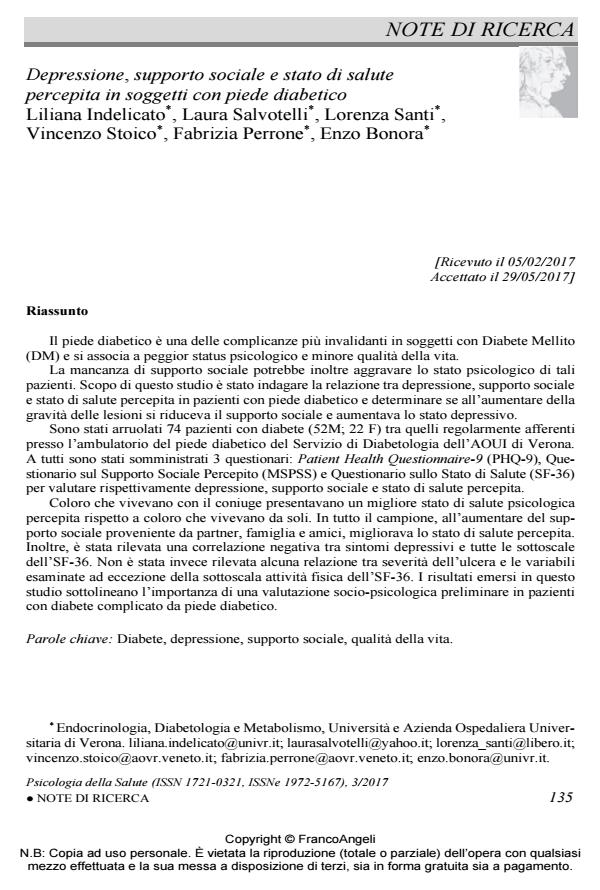Depressione, supporto sociale e stato di salute percepita in soggetti con piede diabetico
Titolo Rivista PSICOLOGIA DELLA SALUTE
Autori/Curatori Liliana Indelicato, Laura Salvotelli, Lorenza Santi, Vincenzo Stoico, Fabrizia Perrone, Enzo Bonora
Anno di pubblicazione 2017 Fascicolo 2017/3
Lingua Italiano Numero pagine 14 P. 135-148 Dimensione file 269 KB
DOI 10.3280/PDS2017-003007
Il DOI è il codice a barre della proprietà intellettuale: per saperne di più
clicca qui
Qui sotto puoi vedere in anteprima la prima pagina di questo articolo.
Se questo articolo ti interessa, lo puoi acquistare (e scaricare in formato pdf) seguendo le facili indicazioni per acquistare il download credit. Acquista Download Credits per scaricare questo Articolo in formato PDF

FrancoAngeli è membro della Publishers International Linking Association, Inc (PILA)associazione indipendente e non profit per facilitare (attraverso i servizi tecnologici implementati da CrossRef.org) l’accesso degli studiosi ai contenuti digitali nelle pubblicazioni professionali e scientifiche
Il piede diabetico è una delle complicanze più invalidanti in soggetti con Diabete Mellito (DM) e si associa a peggior status psicologico e minore qualità della vita. La mancanza di supporto sociale potrebbe inoltre aggravare lo stato psicologico di tali pazienti. Scopo di questo studio è stato indagare la relazione tra depressione, supporto sociale e stato di salute percepita in pazienti con piede diabetico e determinare se all’aumentare della gravità delle lesioni si riduceva il supporto sociale e aumentava lo stato depressivo. Sono stati arruolati 74 pazienti con diabete (52M; 22 F) tra quelli regolarmente afferenti presso l’ambulatorio del piede diabetico del Servizio di Diabetologia dell’AOUI di Verona. A tutti sono stati somministrati 3 questionari: Patient Health Questionnaire-9 (PHQ-9), Questionario sul Supporto Sociale Percepito (MSPSS) e Questionario sullo Stato di Salute (SF-36) per valutare rispettivamente depressione, supporto sociale e stato di salute percepita. Coloro che vivevano con il coniuge presentavano un migliore stato di salute psicologica percepita rispetto a coloro che vivevano da soli. In tutto il campione, all’aumentare del sup-porto sociale proveniente da partner, famiglia e amici, migliorava lo stato di salute percepita. Inoltre, è stata rilevata una correlazione negativa tra sintomi depressivi e tutte le sottoscale dell’SF-36. Non è stata invece rilevata alcuna relazione tra severità dell’ulcera e le variabili esaminate ad eccezione della sottoscala attività fisica dell’SF-36. I risultati emersi in questo studio sottolineano l’importanza di una valutazione socio-psicologica preliminare in pazienti con diabete complicato da piede diabetico.
Parole chiave:Diabete, depressione, supporto sociale, qualità della vita.
- When obtaining support is important. The relationship between optimism, disclosure, and perceived peer support in a sample of young women Conrad Baldner, Clara Amato, Daniela Di Santo, in PSICOLOGIA DELLA SALUTE 3/2018 pp.115
DOI: 10.3280/PDS2018-003006
Liliana Indelicato, Laura Salvotelli, Lorenza Santi, Vincenzo Stoico, Fabrizia Perrone, Enzo Bonora, Depressione, supporto sociale e stato di salute percepita in soggetti con piede diabetico in "PSICOLOGIA DELLA SALUTE" 3/2017, pp 135-148, DOI: 10.3280/PDS2017-003007